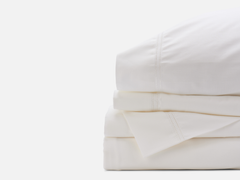Quilts and bedside pillows have a special place in our households. They keep us cozy at night, they add stylish flair to our homes, and they’re even the perfect stage for a comfy backyard picnic. However, with all that use, they’re going to get dirty eventually. Given how special they are to us, tossing them in the wash can be nerve-wracking.
Fortunately, a little detergent and water don’t have to spell doom for your bedding. If you follow the full guide to washing your cotton quilts and shams, you’ll be able to keep your bedding clean without damaging it.
Challenges of Washing Quilts and Shams
There’s a reason that countless quilters worldwide have sworn off washing their quilts—it can be trickier than you would think. A few common challenges that homeowners face when they’re washing their quilts or shams include:
- Quilt stitching becoming loose
- Damaging the fabric
- Fading fabric colors
- Losing the quilt’s longevity
How Often Should You Wash Your Quilts and Shams?
Even though plenty can go wrong when washing your quilts and shams, that doesn’t mean you should never wash them. This is especially true when you use your quilts on your bed, couch, or as a picnic blanket. Dust, dead skin, bacteria, and a host of other nasty things can hang around in your quilt. At the same time, washing any fabric too much can damage it.
How often you wash your quilts and shams depends on how much you use them. For instance, you will need to wash the quilt on your bed far more often than the quilt on your couch. Likewise, the shams you only bring out for special occasions will need far less washing than the ones on the couch.
If you use your quilt frequently, you should wash your quilt every three or four months. For pillow shams, you can typically wash them even less frequently, at about two to three times a year. This number may be lower or higher depending on how dirty they get in your home.
Washing Your Quilts and Shams
There are two main methods for washing any type of bedding—washing machines or handwashing. Both are effective for quilts and shams, but only when they’re done correctly. That’s why our guide to washing your cotton quilts and shams is going to show you how to do either.
How To Machine Wash Your Quilts and Shams Properly
As with washing cotton bed sheets, if the quilt or sham you want to wash is in good condition and made of quality cotton, then you should have no problem putting it in the washing machine. However, there are certain factors that can impact how well it does in the wash.
The Detergent
When you’re choosing a detergent for your quilt, keep the colors of the quilt in mind. Harsh detergents and chemicals like bleach can fade your quilt’s colors and damage the fabric. As much as possible, look for mild or natural detergents for the best results. Also, consider using detergent with “color guard” formulas to keep your quilt vibrant.
The Setting
High heat tends to damage cotton. When you’re choosing your settings, try to lean toward a cold, low-intensity cycle setting to preserve the colors and fabric. Also, inspect the quilt after the wash cycle finishes to check for any residual detergent. If necessary, you may need to perform an extra rinse cycle.
A Note on Germs
There are certain times that you may want to use a high-heat cycle. For example, during cold and flu season, washing your quilt on high heat may be good to help kill any germs. However, try to keep these kinds of wash cycles few and far between.
The Load Size
When we’re doing laundry, our first instinct is often to put as many items of clothing and linens in the wash as possible to cut down on how many loads we have to do. However, overcrowding the washing machine can be bad for both the machine and the things inside.
When you go to wash quilts and pillow shams, try to avoid washing them with other items when possible. Extra items in the wash could potentially damage the quilt, especially when washing rough, bulky items like blue jeans. Your best bet is to keep the quilt on its own and shams with other like items.
How To Handwash Your Quilts and Shams Properly
Sometimes you must roll up your sleeves and knock out a chore by hand. This is especially true if you’re washing an heirloom or antique quilt of pillow shams with embroidery or sequins. To handwash your quilt, follow these steps:
- Fill a tub up with enough water to cover the quilt
- Dissolve a gentle cleaning solution into the tub
- Submerge the quilt in the water and gently scrub the surface.
- Have an additional bucket of water on hand so you can rinse off the soap
- When all the soap is gone, gently squeeze the water out
It’s essential to avoid wringing the water out of your quilt too tightly. Otherwise, you may end up damaging the topstitching, which will shorten your quilt’s lifespan.
Pro-Tip
If you have a quilt that’s mostly for display, you probably don’t need to give it a thorough scrubbing very often. If you want to keep the dust and dirt out of the fabric, you can run a handheld vacuum cleaner brush over the surface.
Should I Take My Quilt to the Dry Cleaners?
Most quilting experts recommend that you avoid taking your quilt to the dry cleaners. Although some locations know how to wash a quilt well, many will use harsh solvents and chemicals on a quilt. The best way to know your quilt survives the process is to clean it yourself.
Tips for Drying Your Quilts and Shams
Machine Drying
If your quilt can handle a washing machine, it can likely handle a cycle in the dryer. Just remember what we said about intense heat on fabric. You will want to dry it on as low a heat setting as possible to avoid damaging the sheets. If it’s taking too long to dry, you can always finish the process by air drying it.
Air Drying
It’s hard not to feel nostalgic at the sight of a quilt on an old-fashioned clothesline. And in this case, the old-fashioned way is one of the safer ways to dry your sheets without damaging them.
However, not all of us have the yard space to hang a large, wet, heavy quilt. If you don’t have room, it’s wise to start by towel drying the quilt’s surface to help make it lighter. Then, invest in a drying rack that you can put up in your patio area or living room. The rack will support your drying quilt without taking up the whole space.
At Red Land Cotton, we know how important good bedding is to your home. That’s why we stitch our quilts and shams made in the USA with the utmost care, making them ready to be part of your family tradition.









